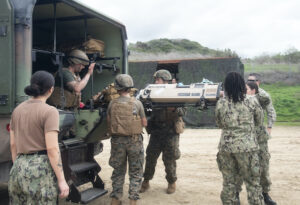
Story by Curtis Hill
Naval Hospital Camp Pendleton
Sailors from Expeditionary Medical Facility 150 Alpha provided the Role 3 medical capability during the 1st Medical Battalion, 1st Marine Logistics Group, Marine Corps Combat Readiness Evaluation from Feb. 26 through March 1, 2024, aboard Naval Expeditionary Medical Training Institute.
Per Office of the Chief of Naval Operations Instruction 3501.176D, Required Operational Capabilities and Projected Operational Environment for the Role 3 Navy Expeditionary Medical Facility, the EMF is “capable of providing Role 3 in a flow-through mode for patients in any operational area, scalable care in terms of beds, providing scalable care by surgical and medical specialists, and providing patient movement.”
The MCCRE provided EMF 150 Alpha a great opportunity to train the way they will fight by setting up the Role 3 capability in a separate location from 1st Med. Bn. to receive, process, and treat patients.
“Expeditionary Medical Facility 150 Alpha personnel integrated with 1st Medical Battalion and Naval Expeditionary Medical Training Institute to exercise the continuum of care across the battlefield, receiving patients from 1st Medical Battalion’s Role 2 Surgical Platoons and Forward Resuscitative Surgical Systems during their Marine Corps Combat Readiness Evaluation,” said Navy Capt. Elizabeth Smith, commanding officer of EMF 150 Alpha.
The exercise provided valuable training and practical application for both commands, but even more valuable was the opportunity to train together.
“The garrison training relationship between 1st Medical Battalion and EMF 150 Alpha will directly affect survivability on the future battlefield,” said Navy Capt. Sean Hussey, commanding officer of 1st Medical Battalion. “Marines and Sailors need the Role 2 and Role 3 teams to spend as much time working together now so that the future wartime hospital system (echelons of care) is primed well before the first casualty is received.”
To facilitate an austere environment, the EMF set up their Role 3 capability aboard the NEMTI training facility in the northern part of Marine Corps Base Camp Pendleton.
“NEMTI’s mission is to ensure readiness of our medical personnel to support the warfighter in austere environments through partnerships across Navy / Marine Corps medical platforms. These events are crucial in providing an opportunity to exercise those partnerships and “train like we fight” with complete integration of Navy and Marine Corps medical personnel simulating real world operations and the roles of care,” said Cmdr. Damian Storz, NEMTI’s officer in charge.
“Our continued collaboration with NEMTI allowed us to utilize their pre-positioned EMF tents, equipment, and subject matter experts to maximize our Role 3 capability,” said Navy Capt. Adolfo Granados, executive officer of EMF 150 Alpha. “This was impactful because we were in the field dealing with conditions similar to real world situations, honing our skills as an expeditionary unit.”
The EMF team obtained great, realistic training and experience during the evolution that will pay dividends in the event they must deploy in support of contingency operations.
“We were able to evaluate Mission Essential Tasks such as command and control, patient movement, patient tracking, and casualty receiving. We also field tested the use of Battlefield Assisted Trauma Distributed Observation Kits (BATDOKs) that allow medical personnel to monitor patient’s vitals wirelessly, from point of injury, autonomously document patient care and transmit data throughout the patient’s continuum of care,” added Smith. “These exercises continue to demonstrate interoperability and warfighting readiness across the Navy and Marine Corps team.”
The EMF team was kept busy each training day with a steady throughput of simulated casualties to maintain the operational tempo of a combat environment.
“Over the course of the MCCRE, EMF 150 Alpha received, treated, tracked, and medically evacuated 76 patients,” said Lt. Jg. Amber Campaign, EMF 150 Alpha’s acting operations officer.
The exercise offered the opportunity to try out some state-of-the-art, emerging equipment on the simulated battlefield.
“We employed medical battlefield technology new to the Navy in the form of the BATDOKs. This is a promising tool for battlefield medical documentation and communication throughout the care continuum,” added Granados. “We will provide feedback to Naval Medical Forces Pacific about their applicability and functionality.”
Taking advantage of an opportunity to include a Role 3 capability during 1st Med. Battalion’s MCCRE was indicative of similar operationally focused mindsets in both commanding officers where combat readiness is paramount.
“We are fortunate to have great partners at EMF 150 Alpha who share our view on expeditionary medical care and who look for opportunities to train together,” added Hussey. “Our recent Marine Corps Combat Readiness Evaluation was a collaborative training exercise that showcased what can be accomplished when Navy and Marine Corps medical teams work together as one system.”
Granados summed up the exercise by saying, “Our personnel performed admirably, were extremely motivated, and were re-invigorated about operational medicine and the phenomenal capability we bring to the fight.”